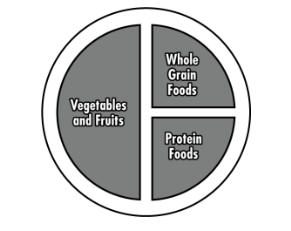a. Suggested Menus
The suggested menus, which appear on the following pages, are designed to help you plan meals that will give you energy and will have all the nutrients necessary for you and your baby.
These menus suggest meals and snacks that are easy to prepare and not too expensive. They suggest foods that are rich in iron, calcium, and folic acid.
The menus may seem to propose more food than you could possibly eat in one day. Remember that your goal should be to eat a variety of foods from Canada's Food Guide. This means that you should eat smaller servings of many kinds of foods rather than large servings of just a few kinds of foods.
Here are some tips for balancing your meals:
-
Make one half of your plate vegetables and fruits, one-quarter whole grain foods, and one-quarter protein foods. If you are using a recipe to make a combination meal, focus on choosing recipes that are mostly vegetables, but also includes some whole grain and protein foods. An example would be a stir-fry that is mostly vegetables, with some chicken added and served on top of whole grain noodles. Another example would be a vegetarian chili recipe made with a base of canned tomatoes, green peppers, and carrots chunks, with kidney beans and chick peas added, and served with whole grain rice. If your meal doesn’t include lots of veggies, choose fruit for a healthy dessert.
-
Snacks should follow the same pattern, but in smaller amounts (for example, use a side plate or small bowl. instead of a dinner plate). You don’t have to include all parts of the plate at every snack, but try to balance them out so they follow the plate pattern over the course of the day.
-
Water should be your drink of choice, but lower fat milk is also a healthy drink that can help you meet some of your extra nutrition needs during pregnancy.
-
Be mindful of your eating habits by following the tips from Canada’s Food Guide to help you be aware of when you’re hungry and when you’re full.




